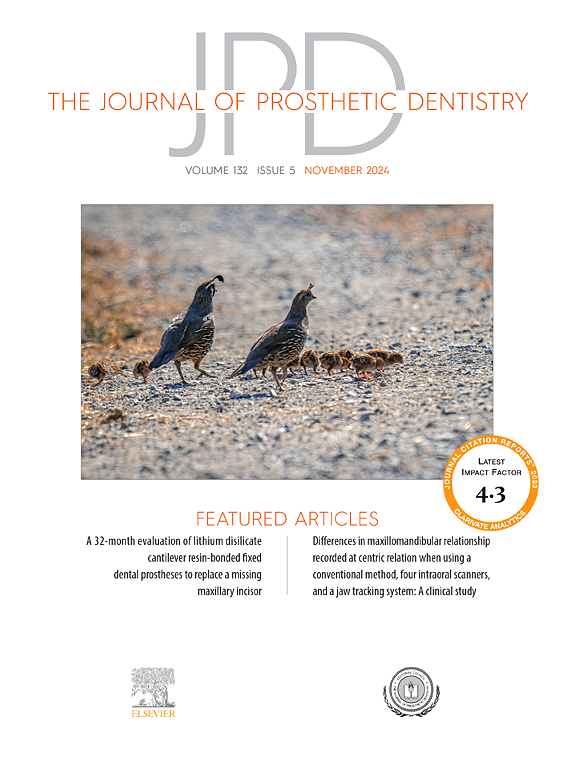Wear behavior of 3D printed, minimally invasive restorations: Clinical data after 24 months in function
IF 4.8
2区 医学
Q1 DENTISTRY, ORAL SURGERY & MEDICINE
引用次数: 0
Abstract
Statement of problem
The prevalence of pathological tooth wear and a reduced vertical dimension of occlusion has increased, but prosthetic rehabilitation concepts have been invasive, time-consuming, and expensive. How affordable, esthetic, and less invasive treatment concepts will perform remains unclear.
Purpose
The purpose of this proof-of-concept clinical study was to evaluate the wear behavior of 3-dimensionally (3D) printed, minimally invasive restorations fabricated from a ceramic- reinforced composite resin material after 24 months in clinical function.
Material and methods
The study included 28 participants who received noninvasive 3D printed restorations made of a computer-aided design and computer aided-manufacturing (CAD-CAM) ceramic-reinforced composite resin material (n=352). Maximum occlusal height loss and mean profile loss were measured by using an intraoral scanner and a matching software program (Geomagic Control X; 3D systems) by 1 clinician. Scans were conducted at baseline and after 12 and 24 months. A descriptive statistical analysis, including mean values, medians, standard deviations (SDs) interquartile range and 95% confidence interval (95% CI) were conducted (α=.05).
Results
Maximum occlusal height loss and mean profile loss were analyzed. The molar restorations showed the highest mean values of maximum occlusal height loss after 12 (0.76 mm) and 24 (1.25 mm) months. The anterior restorations showed the lowest wear rates. In general, 123 restorations (35%) had material wear >0.5 mm and were classified as fractured after 24 months of clinical application. Most of the nonfractured restorations experienced localized material wear between 0.11 mm and 0.35 mm, whereas mean profile loss values varied between 0.05 mm and 0.11 mm.
Conclusions
Three-dimensionally printed, noninvasive restorations manufactured from a ceramic-reinforced composite resin material showed considerable material wear after 2 years of clinical function, and the material appears suitable only for interim restorations.
3D打印微创修复体的磨损行为:24个月后的临床数据。
问题陈述:病理性牙齿磨损和咬合垂直尺寸降低的患病率有所增加,但修复康复概念具有侵入性,耗时且昂贵。如何负担得起,美观,微创的治疗概念仍不清楚。目的:这项概念验证临床研究的目的是评估由陶瓷增强复合树脂材料制成的三维(3D)打印微创修复体在临床功能24个月后的磨损行为。材料和方法:该研究包括28名参与者,他们接受了由计算机辅助设计和计算机辅助制造(CAD-CAM)陶瓷增强复合树脂材料制成的无创3D打印修复体(n=352)。最大咬合高度损失和平均轮廓损失使用口内扫描仪和匹配的软件程序(Geomagic Control X;3D系统)由一个临床医生。在基线、12个月和24个月后进行扫描。进行描述性统计分析,包括平均值、中位数、标准差(sd)四分位数间差和95%置信区间(95% CI) (α= 0.05)。结果:分析了最大咬合高度损失和平均轮廓损失。磨牙修复体最大咬合高度损失的平均值在12个月(0.76 mm)和24个月(1.25 mm)后最高。前牙修复体磨损率最低。总体而言,123例(35%)修复体在临床应用24个月后材料磨损>0.5 mm,归类为骨折。大多数非断裂修复体的局部材料磨损在0.11 mm至0.35 mm之间,而平均轮廓损失值在0.05 mm至0.11 mm之间。结论:三维打印,陶瓷增强复合树脂材料制造的无创修复体在临床功能2年后显示出相当大的材料磨损,该材料似乎仅适用于临时修复体。
本文章由计算机程序翻译,如有差异,请以英文原文为准。
求助全文
约1分钟内获得全文
求助全文
来源期刊

Journal of Prosthetic Dentistry
医学-牙科与口腔外科
CiteScore
7.00
自引率
13.00%
发文量
599
审稿时长
69 days
期刊介绍:
The Journal of Prosthetic Dentistry is the leading professional journal devoted exclusively to prosthetic and restorative dentistry. The Journal is the official publication for 24 leading U.S. international prosthodontic organizations. The monthly publication features timely, original peer-reviewed articles on the newest techniques, dental materials, and research findings. The Journal serves prosthodontists and dentists in advanced practice, and features color photos that illustrate many step-by-step procedures. The Journal of Prosthetic Dentistry is included in Index Medicus and CINAHL.
 求助内容:
求助内容: 应助结果提醒方式:
应助结果提醒方式:


